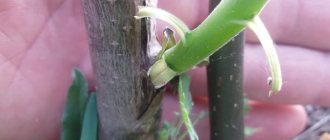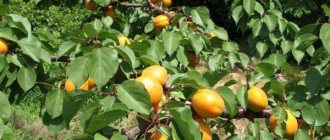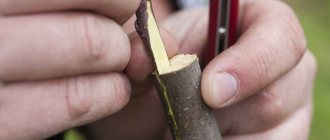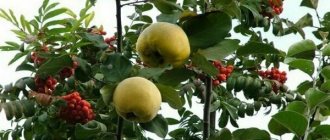2
6022
To understand how to plant lemon at home, you need to study all the intricacies of the process. Plant grafting is a vegetative propagation method actively used in gardening. Thanks to such manipulations, fruit crops begin to bloom faster and produce abundant harvests.
Homemade lemons
General rules
To successfully graft citrus fruits and get a fruit-bearing plant in the future, you should consider several important rules:
- To carry out manipulations you will need a sharp object. They will need to cut off the graft material. A medical scalpel, blade, stationery knife or a special machine is suitable for this purpose.
- Before cutting the graft, the trunk of the cultivated plant should be wiped with a dry cloth, removing any remaining dust. For disinfection purposes, it is necessary to wipe the central conductor of the rootstock at the grafting site.
- Before starting the manipulation, you should cut off the unnecessary shoot from the rootstock plant. If the bark comes off easily from this branch, the bud survival rate will be high. The bark does not come off well - you need to wait until new shoots grow and do another test.
- The thickness of the rootstock and scion should be approximately the same. In case of mismatch, it is necessary to combine their cortex as much as possible in at least one place.
- To secure the scion to the rootstock you will need adhesive tape. The most convenient and effective material that does not allow moisture and air to pass through is latex. You can use regular medical gloves cut into strips.
- Using this material for tying, you will not need to cover the plant with glass or a bottle to protect it from sudden changes in temperature and changes in humidity levels.
Features of the procedure
Vaccination methods are easy to carry out at home, due to their simplicity and accessibility. The technology of the procedure assumes that:
- manipulations will be carried out in a short period of time to avoid the start of the process of oxidation of plant tissues under the influence of air,
- during the process, disinfected equipment will be used to prevent bacterial and fungal infections from entering plant tissues,
- the cuts on the scion and rootstock will be smooth,
- The grafting sites on the rootstock will be pre-washed with soapy water and treated with a fungicidal agent.
The optimal time for vaccination at home is May; when carrying out the procedure in an unheated greenhouse, this period shifts to June. It is recommended to carry out the grafting procedure in a humid room, and when growing citrus fruits in a greenhouse - in rainy weather, since high humidity contributes to the effectiveness of its result, preventing the grafting site from drying out.
During subsequent care after the procedure, a mini-greenhouse is created for the grafted citrus. Covering it with polyethylene or covering it with a glass jar is suitable.
Copulation
An effective and proven way to plant citrus at home. The height is determined by the method of operation, the thickness of the rootstock and scion. The higher the graft is made, the stronger the influence of the rootstock. Typically, grafting is done at a level of 20 cm from the soil surface.
There are certain rules for preparing a rootstock and scion for copulation:
- The sections are made absolutely even, smooth, and only with a sterile sharp object. Such material will fit tightly to each other, preventing air and moisture from passing through.
- The cutting areas should be of the same diameter so that when joining, the cambium areas of the scion and rootstock coincide as much as possible.
- For successful copulation, it is necessary to ensure a large area of fusion of the two parts, so a long, elliptical cut is made on the rootstock and scion.
- Opposite the cut there should be a bud, which will subsequently provide nutrients to the cut areas, and the fusion of the scion bark with the rootstock.
- Each grafting cutting must have at least 4 buds.
Stages of implementation
The scion will be connected to the rootstock, ensuring maximum cambium matching. Then wrap it tightly with latex tape. The edge of the winding is tightened into a loop.
After this, the plant is placed in a warm place, watered abundantly and covered with a transparent film or half a plastic bottle.
While the grafting takes root, the plant must be ventilated and periodically irrigated with a spray bottle.
If the diameters of the rootstock and scion are different, you should not use the copulation method, because the chance of scion survival will be negligible. In this case, preference is given to budding or grafting into the cleft.
Vaccination methods
I mainly use three options: budding, copulating and splitting. The grafting options and their technique are absolutely no different from other fruit trees. Therefore, if you already have experience in grafting fruit trees in the garden, there should be no problems with citrus fruits. Naturally, we make allowances for the size and thickness of branches and plants.
It is important to know
Some citrus fruits are best rooted rather than grafted. For example, you can get a full-fledged plant faster if you root cuttings of lemon, orange, citron grapefruit, and they grow well on their roots.
Budding
To plant citrus in this way you will need a healthy cultivated plant. Of all the shoots, you should choose a well-ripened branch with 2-3 buds. The leaves are removed from the cuttings so that the petioles remain intact. It will be convenient to hold the kidney during grafting.
In order for the manipulation to be successful on the rootstock plant, it is necessary to cut out all the foliage, leaving only 2-3 pairs of leaves. Young shoots of the current year are also subject to cutting. All nutrition should go not to the growth of green mass of the rootstock, but to the survival of the graft.
After budding, it will be possible to determine from the petiole how successful everything went:
- if after 10 days the petiole turns yellow and falls off, the grafting was successful;
- a blackened and shriveled petiole is a sign of bud death.
Technique
Budding at home is carried out as follows:
- A suitable place for grafting is selected on the rootstock bark. Then a T-shaped notch is made.
- Using a sharp object, cut the buds from the prepared cuttings along with the petiole and bark. The length of the scion should match the length of the T-shaped cut on the rootstock.
- The prepared heel is inserted into the T-shaped cut. The scion is then tightly tied with latex tape, pressing tightly against the rootstock. The winding is carried out from the bottom up, so it is important to ensure that the grafting does not shift. The petiole with the bud should remain outside. Upon completion of the winding, the tape is pulled through the loop.
- After the manipulations, the plant should be watered abundantly to stimulate the process of sap flow. It is placed in a warm place where there are no drafts and sudden temperature changes, and provides protection from the scorching sun during lunch hours.
- For 10 days (during this time the bud should take root), it is necessary to monitor the growth and development of the rootstock. All buds formed at the top of the plant should be ruthlessly cut off, because they slow down the process of survival of the grafted kidney.
- As soon as the first shoot that has sprouted from the bud becomes stiff and produces at least one leaf, the apical shoot of the rootstock is pruned. Cut the central conductor to the place where leaves and branches begin to form, leaving 3-4 cm in length. The exposed shoot will serve as a kind of support for grafting. At first, the flexible grafted part will grow to the side, so it can be freely tied to the remaining part of the central conductor. To do this, use wire or clothespin. After some time, the branch obtained from the graft will get used to the vertical position, become woody, and will no longer need a garter.
After successful grafting, there is no need to remove the garter, because latex is a natural material and can decay on its own.
How to properly plant lemon at home
Vaccination is a complex operation. The personal experience of the specialist conducting it means a lot. Before you plant a lemon at home, you should familiarize yourself with all the nuances of this work, and also watch videos that are very easy to find on the Internet.
But even after this, it is better to get the first vaccination under the supervision of an experienced specialist. There are several methods of lemon grafting, each of which has its own characteristics.
What time of year is it better to plant lemon and what is required for this?
Lemon grafting is usually done during intense sap flow. The timing of lemon grafting is from mid-April to the end of May. The grafting itself is carried out during a humid rainy period, when the eyes and cuttings of the scion are reliably protected from drying out.
Grafting using the copulation method is carried out in early spring before the start of sap flow. It is better to use a plant grown from a seed as a rootstock. You can also graft onto varietal specimens of Meyer lemon or Dioscuria. Other types of citrus fruits can be used for rootstock. Grapefruit or orange will do. These plants can also be grown from seeds.
For successful grafting, their diameter should be about 0.5 cm.
For the scion, take a cutting or bud of any variety of indoor lemon, the fruits of which you would like to obtain. It is better to take dwarf varieties so that the plant does not grow so intensively after grafting.
The scion is taken from an already fruiting plant. If you graft a cutting from a specimen that has not yet produced fruit, then in the future this graft may not bear fruit at all. To carry out the operation you will need the following tools and materials:
- Secateurs;
- Budding knife;
- Blade;
- Cotton wool and fabric;
- Garden tape;
- Garden var.
Budding method
Budding is the process of merging a rootstock with a bud or cutting of another plant. The bud or cutting is inserted under the bark of the rootstock, on which a “T”-shaped cut is made for this purpose. This operation is considered the least traumatic to the rootstock plant and simple to perform.
The rootstock plant at the grafting site is wiped with a damp cloth or cotton wool. Then a “T”-shaped cut of the bark is made on the trunk at a distance of 7-8 cm from the ground. Its dimensions should be as follows: width – 1 cm and length – 2.5-3 cm.
The edges of the bark are folded back to form a kind of “pocket” for the scion. Excess bark is carefully trimmed to leave space the size of the lower part of the scion. A bud from a cutting of a fruiting lemon is used as a scion.
The cutting usually contains several buds. The largest and most powerful one is selected, and then with a sharp knife it is cut off with a small amount of bark and wood. The length of the scion should be 2.5 cm: 1 cm of bark on top of the bud and 1.5 cm below.
The scion is wiped with damp cotton wool and inserted into the “pocket” formed by the cut bark. Then the grafting site is wrapped with garden tape. The top can be carefully coated with garden varnish to prevent drying out. Sometimes 2 vaccinations are given on the rootstock at once. After the grafted bud begins to grow, the top of the rootstock is cut off. How to properly plant a lemon at home using the budding method, watch this video:
Copulation method
Copulation is a method of merging a scion and rootstock of equal diameter. The procedure is carried out before the sap begins to flow in early spring. Copulation can be simple or improved. When carrying out simple copulation, the rootstock and scion are cut at an oblique angle.
It is important that the cut areas are the same. Then the sections are combined with each other and tied tightly with garden tape. The grafting site is covered with garden varnish on top. The disadvantage of this method is the possibility of the slices shifting relative to each other.
To prevent displacement of the slices, copulation is carried out in an improved way. Improved copulation begins in the same way as regular copulation. The compatible parts are cut at an angle and their compatibility is checked. Next, a vertical oblique cut 1 cm long is made in the middle of the rootstock.
A counter-cut is also made on the scion so that the rootstock and scion fit tightly together. The connected parts are tied with garden tape. Improved copulation eliminates displacement of graft parts. It also provides a contact area that is significantly larger than with simple copulation. You can watch how to plant an indoor lemon using the copulation method in this video:
Grafting a lemon into a cleft
Split grafting or cutting consists of grafting a scion cutting directly into the center of a split rootstock. For this method, a young cutting with several buds is cut. Its bottom is formed with a wedge - 2 oblique cuts 2.5-3 cm long are made.
Grafting into a cleft severely injures the rootstock. Therefore, before starting this procedure, you need to make sure that everything is in order with its roots.
A healthy rootstock is cut horizontally at a distance of 7-8 cm from the ground, after wiping the cut area with a damp cloth or cotton wool. After the cut is formed, you need to make a vertical cut in the middle of the stump to a depth of 2.5-3 cm.
The prepared scion, cut with a wedge, is tightly inserted into this section. After this, the grafting site is tightly wrapped with garden tape. After tying, the upper cut of the hemp should be generously lubricated with garden varnish. This is a mandatory procedure so that the bare cut does not dry out.
To increase the effectiveness of such grafting, 2 scion cuttings are prepared at once.
They are placed in a hemp cut at some distance from each other. If grafting is carried out correctly, at least 1 cutting should take root. Placing grafted cuttings under a plastic bag also gives good results. To graft indoor lemon into a cleft at home, see the video below:
Into the cleft
This grafting is well suited for beginning gardeners. The best time for manipulation is April-August.
The rootstock plant is cut into a ring. Leaves are removed from the scion cuttings. The petioles are cut into wedges: the longer they are, the better. A split is made in the center of the rootstock and a scion blade is inserted so that the bark is aligned. Then the grafting site is wrapped with tape, leaving the graft itself outside. After grafting, the plant is watered and then placed in greenhouse conditions.
Features of lemon grafting
You can vaccinate one standard from several varieties. During fruiting, the tree will produce citrus fruits of different shapes, weights and tastes. Lemons on sale are the fruits of hybrids; after the seed germinates, it can be difficult to determine what species the seedling belongs to. The tree may have signs of orange or grapefruit, vaguely reminiscent of a classic lemon. For grafting, these qualities do not play a role; as a result, fruiting will be of the varieties that are grafted.
Grafting is carried out with material from trees that have already bear fruit. The retail chain sells lemons with fragments of green mass; they can be used as a scion. Only fresh branches are used, first dipped in water for several hours so that the plant restores turgor. The survival rate of such a vaccination is worse, but you can try.
Caring for the graft
Caring for grafted plants consists of following simple measures that will ensure their rapid growth and early fruiting.
Throughout the growing season, citrus is watered moderately and regularly - as the top layer of soil dries out. A day after each watering, the soil is loosened to increase its aeration and prevent the formation of crust.
The grafted citrus must be provided with the highest possible level of humidity (as in a bathhouse). Therefore, the greenhouse cover is removed daily for 30-40 minutes, then the plant is irrigated with a spray bottle and covered again with film or a jar. The optimal temperature for keeping grafted plants is 20-25 °C.
Fertilizing can be applied only 3 months after the grafting has taken root. Complex fertilizers for citrus fruits are used as fertilizers.
After 1-1.5 months, when the grafting gets stronger and produces a new shoot and leaf, the greenhouse cover is removed. Grafted plants require the same care as planted cuttings. Therefore, they are placed in a warm place, protected from the sun and wind, watered regularly, the crown is irrigated with a spray bottle and high air humidity is provided - 70-80%.
Positive aspects of vaccination
In the process of grafting citrus fruits, it is permissible to use plants of the same varietal variety or closely related ones, in this case:
- the grafted plant becomes resistant to the negative effects of the environment, its appearance improves,
- it becomes possible to propagate a plant in a short time and cross different citrus fruits with each other,
- the time for flowering and fruiting to occur is significantly reduced,
- fruits with improved quality characteristics are obtained and their quantity increases.
Advice from experienced gardeners
A few recommendations from gardeners on how to get fruit from lemon grown from a seed:
- Don't waste time waiting for fruit, the lemon needs to be grafted.
- Plants no older than 3 years old are suitable for rootstock.
- Take material from trees of a good variety that have already bear fruit.
- For the first 1.5 months, create a greenhouse effect for the lemon.
- Protect the tree from drafts and sudden changes in temperature.
- When budding, make several vaccinations in different areas.
Be sure to remove shoots on the rootstock branch as soon as they appear.











